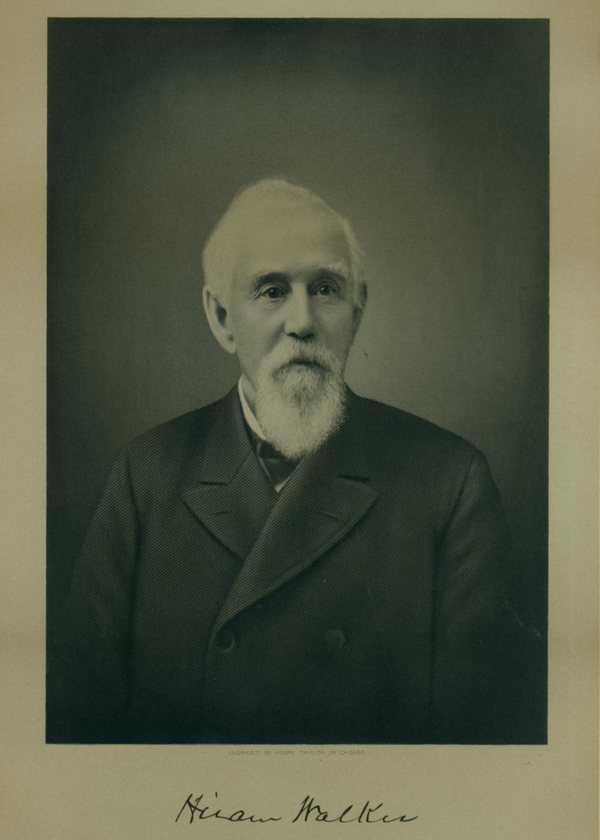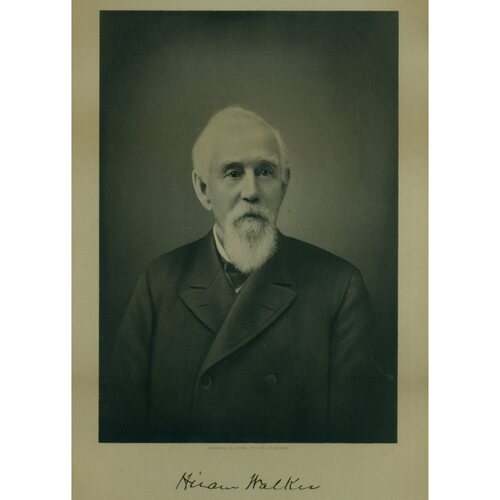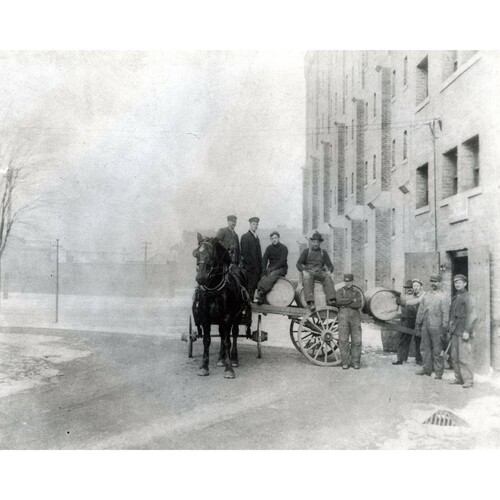
Source: Link
WALKER, HIRAM, businessman and philanthropist; b. 4 July 1816 in Douglas, Mass., son of Willis Walker and Ruth Buffum; m. 5 Oct. 1846 Mary Abigail Williams, and they had five sons and two daughters; d. 12 Jan. 1899 in Detroit.
In 1838, at the age of 22, Hiram Walker moved from his boyhood home of Douglas to Detroit, where he launched several unsuccessful business enterprises. It was not until he had established the Walker Wholesale and Retail Store there, by 1850, that his ventures realized any success. Grocery stores like his sold liquor and in 1854 Walker decided to experiment with distilling. His whisky became popular and it appeared that he had found the road to prosperity.
Walker’s success as a distiller was tempered somewhat by an ambivalence in Michigan towards temperance. In 1855 a law was passed by the state legislature that limited the vending of liquor to druggists, for medicinal purposes. The law was never effectively enforced, but the resulting uncertainty was such that Walker began to diversify his interests by becoming involved in the grain-buying business. As a supplier of grain for Detroit millers, he made his initial contact with Upper Canada and became familiar with the southwestern part of the province.
An astute businessman, Walker found that the Windsor area held out a number of attractions to him. The Great Western Railway was completed from Niagara Falls to Windsor in 1854 with connections to the American Midwest and to points on the eastern seaboard. The importance of the railway was enhanced by the signing of the Reciprocity Treaty of 1854, which provided for the reciprocal free admission of such natural products as grain and livestock. Then, too, real estate was less expensive in the Windsor area than in Detroit. Moreover, there were relatively few distilleries along the Canadian side of the Detroit River, and Upper Canada was not at the time as repressive in temperance matters as Michigan. Finally, as a grain-dealer, Walker must have realized that the Windsor area had no steam-driven milling facilities, although an abundance of grain existed to sustain such an activity. A steam-powered mill could outproduce the several antiquated windmills that dotted the southern shore of the Detroit River. All of these considerations led Walker to purchase land in Upper Canada in 1856 with a view to establishing a milling and distilling operation.
In 1857 he made daily trips from Detroit to supervise the construction of his enterprise on the riverfront a short distance upstream from Windsor. By December he had opened a grocery store, vinegar manufactory, and steam-mill. Two years later the Walker family left Detroit and moved into a large frame-house, the Cottage, near his operations. By this time the Windsor Distillery and Flour Mill (as they were originally known) was established. In his usual resourceful manner, Walker used the distilling wastes to fatten livestock and by the early 1870s yards adjacent to the distillery were often filled with animals awaiting shipment. In 1864, with all his projects doing well, he returned to Detroit, where he lived for the remainder of his life. Still, much of his time was spent supervising his Canadian holdings, which began to form the nucleus of a small community, known interchangeably as Walkerville and Walkertown. By 1867 the settlement contained the distillery, a hotel, a store, and “several tenements built by Walker and Co., for the convenience of their employees, which number from eighty to one hundred.” On 1 March 1869 the Canadian government officially recognized Walkerville as a post-office village.
By the early 1880s the village had a population of 600 people, who lived in homes built and owned by Hiram Walker. They worked in Walker-owned industries, drank water pumped through pipes laid by him, received police and fire protection at his expense, and could attend the church built by him (named St Mary’s in memory of his wife, who had died in 1872) . In the absence of a commercial bank, Walker’s employees could deposit their savings in the private Walker bank. Walkerville had become a typical company town ruled over by a benevolent founder and his sons and relatives.
Until early in that decade Walker’s interests in Canada lay primarily with the distillery. However, in the mid 1880s he and his sons began to diversify. In 1880 Walker Sr had leased the ferry Essex from the Jenking Brothers shipyard just below Walkerville. Docking facilities were constructed near the distillery and in Detroit. Eight years later this enterprise became the Walkerville and Detroit Ferry Company, with Hiram and his sons as its executive officers. Walker also turned his entrepreneurial talents to the task of railway building. He owned extensive properties in southern Essex County which were likely to increase in value with the introduction of rail facilities. Moreover, the 1880s was a period of rapid rail expansion fuelled in part by substantial subsidies from the federal government. Undoubtedly these factors were considerations in the distiller’s actions leading to the incorporation of the Lake Erie, Essex and Detroit River Railway in 1885. By the spring of 1889 the line had been completed as far as Leamington and in 1901 the railway reached its eastern terminus, St Thomas. The Lake Erie and Detroit River Railway, as it was known then, had become an important line. Many rural people patronized the railway company’s excursions to Detroit and nearby Belle Isle, utilizing Walker’s ferry service in the process. The railway also gave impetus to a new industry: the shipment of fresh fruit, vegetables, and fish from southern Essex to Detroit and Windsor. Perishables shipped from Leamington at night could reach Detroit’s markets the next morning.
The construction of the railway was followed by the establishment in Walkerville of a large number of industries, among them the Detroit drug firm of Parke, Davis and Company, the Globe Furniture Company, the Walkerville Malleable Iron Company, the Ontario Basket Company, and the Milner-Walker Wagon Works, the forerunner of the Ford Motor Company of Canada [see Gordon Morton McGregor*]. Additional industries moved into the village before the turn of the century, creating an impressive industrial complex along Walker Road. The period between 1885 and 1900 was a time of transition for Walkerville. The tiny hamlet of the 1850s had become an important centre of diversified industry.
Concurrent with its industrial development, Walkerville was preparing for town status. On 29 Jan. 1890 a petition was forwarded to the Ontario legislature requesting Walkerville’s incorporation as a town and citing the significant contributions of the Walker family to the development of the settlement. Prominent among the 208 names on the petition were those of Hiram Walker, his three surviving sons, and two nephews. Since its inception Walkerville had been under the jurisdiction of Sandwich East Township. However, as its population increased and it became more industrialized, the village required additional territory for future development and homesites for the workers. Meeting these needs meant planning, and the delineation of definite municipal boundaries through incorporation would make the planning easier.
Incorporation would release Walker and his sons from the continued maintenance of the police force and fire department. As a town, Walkerville would enjoy increased stature, and handsome profits would accrue to the Walkers as owners of extensive real estate. At the same time the family could expand its lighting and water systems, an additional source of revenue. Another factor in the decision to seek a change in status, the possible annexation by neighbouring Windsor, would undoubtedly have been repugnant to the eldest Walker. Powerful as he was in Walkerville, his influence would diminish considerably if it became part of a larger municipality. In a separate, self-governing community, his authority would likely suffer but as Walkerville’s foremost taxpayer he would be able to retain some influence. Thus for many reasons the Walker family clearly favoured the transition to town status. On 7 April 1890 the act of incorporation was passed. The first mayor of Walkerville was Hiram Alexis Walker, a nephew of the founder. After incorporation, Edward Chandler Walker, Hiram’s eldest son, made his home there in a large mansion, Willistead, and so the Walker influence continued in local matters. Walkerville eventually became part of Windsor in 1935.
The year 1890 also witnessed a corporate restructuring of the various Walker interests in Canada. Since 1873 these had operated under the corporate umbrella of Hiram Walker and Sons, comprising Hiram and his sons, Edward Chandler, Franklin Hiram, and James Harrington. In 1890 it was decided to separate the interests and to that end the several individual companies were incorporated. Hiram Walker and Sons Limited continued to be associated with the manufacturing and marketing of distillery products. Most of Walker’s Canadian real-estate holdings were placed under the Walkerville Land and Building Company. The utilities installed by the Walkers during the early years of the town’s development went under the Walkerville Gas and Water Company Limited. That year also witnessed an expansion of the distillery, after the Canadian government had passed a statute compelling distillers to hold their products in maturing casks for two years before placing them on the market. In compliance, additional warehouses were constructed, bringing the storage capacity of the plant to five million gallons.
Walker’s interests in Walkerville had failed to absorb all of his energy, and he remained active as an entrepreneur in Detroit after his return there in 1864. His name was associated with such enterprises as the Detroit Car Works, the Detroit Transit Railway, the National Bank of Detroit, the Michigan Land and Immigration Company, and the Hamtramck Iron Works. He owned extensive real estate, including important parcels of land in the central business district. He was also a prominent shareholder in the Detroit Advertiser and Tribune, a Republican newspaper, but he was not successful in that business and divested himself of his newspaper holdings in 1881.
Walker played an important role in the founding and development of Walkerville, where he functioned as a benevolent despot. Although he was an absentee landlord, he seemed to take a genuine interest in the well-being of the town and its inhabitants. An Episcopalian, Walker was a member of St Paul’s Church in Detroit. He was an active philanthropist in the Detroit-Windsor area, particularly with respect to the Children’s Free Hospital in Detroit. In 1895, in declining health, Walker retired from his various business interests and transferred his holdings to his three sons. He suffered a paralytic stroke that year and in 1899 died at his residence in Detroit. His sons and grandsons ran Hiram Walker and Sons until 1926, when Harry C. Hatch* bought it for $14 million.
Although he had had little formal education, Hiram Walker was a highly successful entrepreneur in both the United States and Canada. A hard-driving opportunist, he expected those individuals associated with his enterprises to be equally industrious and he appears to have had little time for those less energetic than himself. His sons were groomed at an early age to take their places in the various family business interests. Accordingly, these interests were in good hands when Walker found it necessary to retire. In business, his objective was to be, as nearly as possible, self-sufficient, and many of his activities, such as the railway and livestock enterprises, were ancillary to his distillery operations.
AO, Hiram Walker Hist. Museum Coll., 20–228, H. A. Walker, account-book, January 1869–12 April 1898. Hiram Walker and Sons, Ltd., Public Relations Office Library (Walkerville [Windsor], Ont.), F. X. Chauvin, “Hiram Walker, his life and his work and the development of the Walker institutions in Walkerville, Ontario” (typescript, [1927]). Mich. Pioneer Coll. (Lansing), 10 (1886): 200–1. Commemorative biographical record of the county of Essex, Ontario . . . (Toronto, 1905). R. G. Hoskins, “A historical survey of the town of Walkerville, Ontario, 1858–1922, including an evaluation of the influence of Hiram Walker and his sons on the growth and development of the town until 1922”
Cite This Article
Ronald G. Hoskins, “WALKER, HIRAM,” in Dictionary of Canadian Biography, vol. 12, University of Toronto/Université Laval, 2003–, accessed December 16, 2025, https://www.biographi.ca/en/bio/walker_hiram_12E.html.
The citation above shows the format for footnotes and endnotes according to the Chicago manual of style (16th edition). Information to be used in other citation formats:
| Permalink: | https://www.biographi.ca/en/bio/walker_hiram_12E.html |
| Author of Article: | Ronald G. Hoskins |
| Title of Article: | WALKER, HIRAM |
| Publication Name: | Dictionary of Canadian Biography, vol. 12 |
| Publisher: | University of Toronto/Université Laval |
| Year of publication: | 1990 |
| Year of revision: | 1990 |
| Access Date: | December 16, 2025 |




